| Pages:
1
2 |
Magpie
lab constructor
    
Posts: 5939
Registered: 1-11-2003
Location: USA
Member Is Offline
Mood: Chemistry: the subtle science.
|
|
Preparation of Bromine
Preparation of Bromine
by Magpie
12/10/09 Rev2
Introduction
This procedure is for the preparation of ~25mL of Br2 using swimming pool grade NaBr, Rooto sulfuric acid, and 35% H2O2. The yield is very near
theoretical.
The following oxidation-reduction reaction applies:
2NaBr + H2SO4 + H2O2 = Br2 + Na2SO4 + 2H2O
CAUTION
Br2 is toxic, and some excess will be vented through the port on the vacuum adapter. Therefore this procedure must be conducted outside or in an
efficient fume hood. (Note 1)
Do not spill any Br2 on your person. It will cause nasty and long-lasting burns.
Procedure
A. Reagent Preparation
Weigh out 100g of NaBr in a beaker. Set aside.
In a 250mL beaker place 50mL of water. To the water carefully add, with stirring, 30mL of Rooto sulfuric acid (96wt%). The beaker should be cooled
in a cold water (or ice water) bath during the addition of the acid. Set aside.
Have available 45mL of 35% H2O2 or an equivalent amount of aqueous H2O2 of a different strength.
B. Equipment Set-Up
Using a 500mL round bottom flask (RBF) as pot and a 50mL RBF as receiver, set up for simple distillation. A pressure-equalizing addition funnel with
sufficient capacity to hold the H2O2 solution is to be attached to the top port of the distillation adapter. All fittings are to be of ground-glass,
coated with a thin film of silicone grease, and clamped.
Ice-water is to be supplied to the condenser. The receiver is to be placed in an ice-water bath. (The boiling point of Br2 is 59°C.)
Heating is to be supplied with a 270w Glas-Col mantle (or equivalent) placed on top of a magnetic stirrer. Place a stir-bar in the 500mL RBF pot.
C. Distillation
Temporarily remove the 500mL pot from the apparatus and add the acid prepared above. Using a powder funnel, add, with magnetic stirring, the weighed
out NaBr. Replace the pot in the apparatus. Keep the stir bar in operation to provide good mixing.
Connect the pressure-equalizing funnel to the top of the distillation adapter (valve closed!). Add the H2O2 solution prepared above to the pressure
equalizing funnel and install its plug in the fill port.
Turn on the cooling water. Set the heating mantle at 60% and turn on. If using a hood, turn on the fan.
WARNING
Be very careful when adding the hydrogen peroxide, as an uncontrollable reaction can result if too much hydrogen peroxide is in the mixture.
When the pot has reached a temperature sufficient to support the reaction add the H2O2 solution a few drops at a time, keeping the reaction under
control. A steady generation of Br2 will follow. The reaction is exothermic and the heating mantle power should be turned down as the pot heats up.
By not overheating, the loss of Br2 via the vacuum adapter port will be minimized.
Continue the distillation after all the H2O2 solution has been added until the generation of Br2 has nearly stopped. There should be ~25mL of Br2 in
the receiver.
Drying the Br2
The liquid Br2 will be wet with some water, much of it floating on the surface. This can be removed by shaking it with con sulfuric acid in a
separatory funnel that has been pre-cooled in the freezer. The heavier bromine (sp. gr. = 3.12) is drained off the bottom of the separatory funnel.
Storage
A narrow necked glass bottle with a PTFE lined cap is suitable for storage. Keeping it in a freezer will minimize any leakage.
Notes
1. SM forum member "not_important" has suggested that the fugitive Br2 escaping at the vacuum adapter port can be safely captured by bubbling it into
a solution of NaOH, KOH, warm Na2CO3, or warm K2CO3. For example: 3 Br2 + 6 KOH => 5 KBr + KBrO3 + 3 H2O
2. The H2SO4 is in 14% excess.
3. The H2O2 is in 8% excess.
Reference
This procedure is based on the recommendations of benzylchloride1 of the ScienceMadness forum.
Photos
Photos will follow when available. In their stead is the following photo taken during the production of Br2 using a less efficient procedure.
[Edited on 7-12-2009 by Magpie]
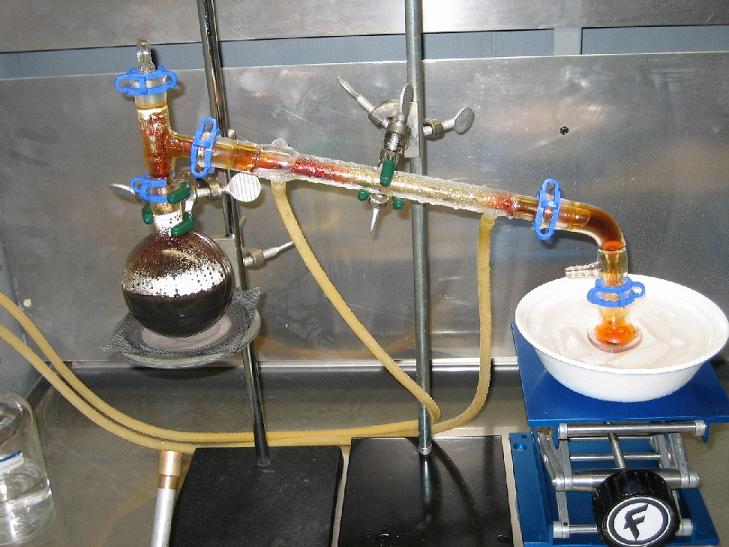
[Edited on 7-12-2009 by Magpie]
[Edited on 8-12-2009 by Magpie]
[Edited on 8-12-2009 by Magpie]
[Edited on 10-12-2009 by Magpie]
The single most important condition for a successful synthesis is good mixing - Nicodem
|
|
|
Arrhenius
Hazard to Others
  
Posts: 282
Registered: 17-8-2008
Location: US & A
Member Is Offline
Mood: Stochastic
|
|
Looks good. Can you elaborate on the amount of heat you applied to the reaction? Possible ways to trap bromine vapor leaving take-off adapter
(safety)? Yield from NaBr?
|
|
|
Magpie
lab constructor
    
Posts: 5939
Registered: 1-11-2003
Location: USA
Member Is Offline
Mood: Chemistry: the subtle science.
|
|
Quote: Originally posted by Arrhenius  | | Looks good. Can you elaborate on the amount of heat you applied to the reaction? Possible ways to trap bromine vapor leaving take-off adapter
(safety)? Yield from NaBr? |
The heat should be adjusted to maintain good production yet not overwhelm the condenser. This has to be done by observation. Good modulation of the
heat will minimize the bromine lost at the vent.
There surely are ways to trap the vented bromine. I have never used any and don't off hand know what would be practical. Bubble into a thiosulfate
solution?
I can easily calculate the yield.
I'll make these additions to the procedure tommorrow. Thanks.
The single most important condition for a successful synthesis is good mixing - Nicodem
|
|
|
not_important
International Hazard
    
Posts: 3873
Registered: 21-7-2006
Member Is Offline
Mood: No Mood
|
|
Absorb it in Na/KOH solution
3 Br2 + 6 KOH => 5 KBr + KBrO3 + 3 H2O
Evaporation and extraction of excess hydroxide leaves a mix that will produce B2 on addition of aqueous acid
5 KBr + KBrO3 + 6 H(+) => 3 Br2 + 6 K(+) + 3 H2O
I believe warm carbonate solution can be used in place of hydroxide.
|
|
|
benzylchloride1
Hazard to Others
  
Posts: 299
Registered: 16-3-2007
Member Is Offline
Mood: Pushing the envelope of synthetic chemistry in one's basement
|
|
Magpie, I like your method for the production of bromine, I use a similar method all the time for the preparation of bromine since I use a large
quantity of bromine in the synthesis work that I conduct. I have conducted this preparation of bromine using two times the amount of reagents in a
1000 ml flask; this allows the preparation of approximately 1 mole of Br2 in about 2 hours. Magpie, was the picture that you posted of the manganese
dioxide method of producing bromine? Be very careful when adding the hydrogen peroxide, as an uncontrollable reaction can result if too much hydrogen
peroxide is in the mixture.
Amateur NMR spectroscopist
|
|
|
Magpie
lab constructor
    
Posts: 5939
Registered: 1-11-2003
Location: USA
Member Is Offline
Mood: Chemistry: the subtle science.
|
|
Quote: Originally posted by benzylchloride1  | | Magpie, I like your method for the production of bromine.... Magpie, was the picture that you posted of the manganese dioxide method of producing
bromine? Be very careful when adding the hydrogen peroxide, as an uncontrollable reaction can result if too much hydrogen peroxide is in the mixture.
|
>Thanks, I tried to follow your recommendations. I think the yield is fantastic and vastly superior to my previous methods.
>Yes, that's where I got the picture.
> Thanks for the warning. I'll add that to the procedure.
What wt% H2O2 do you normally use?
[Edited on 10-12-2009 by Magpie]
The single most important condition for a successful synthesis is good mixing - Nicodem
|
|
|
Jor
National Hazard
   
Posts: 950
Registered: 21-11-2007
Member Is Offline
Mood: No Mood
|
|
When I distilled bromine once, and saw the deep red vapours red, it was an incredible sight, and was scared but at the same time amazed. Bromine
vapour at RT is orange. But when it boils you see clouds of dark red vapour rise, while al in the RB dark red droplets condense. If hell exists it
looks like that 
Also after no more is coming over, your apparatus will be filled with bromine vapour, with only slowly diffuses out. Now take out the thermometer. At
once a LOT of of vapour will run out, and at that point you'd better have the hood running 
I like the method. It's cheaper than mine. But I don't like the hassle of distilling it. Also I hardly ever distill since I have the hood, since my
appratus only just fits in it (I bought a large NS29 (250ml flasks) only leaving me 10cm more horizontal space, wich makes working unsafe. I am still
in need to buy a smaller NS19 set.
I dissolve KBr in water, and add conc. H2SO4 (18mL per 25g), slowly. Then I let cool and filter the KHSO4. To this solution a slight excess of KBrO3
is added in portions with magnetic stirring, and the bromine is pipetted out, giving me a yield of about 80% (the rest remains dissolved. Dissolving
KBr in staright dil. H2SO4 and adding KBrO3 produces a lot of precitipate, KHSO4, wich makes pipetting bromine much harder.
Much safer than distilling IMO, and gives an acceptable yield.
Scrub bromine with NaOH-solution, this works great.
|
|
|
Magpie
lab constructor
    
Posts: 5939
Registered: 1-11-2003
Location: USA
Member Is Offline
Mood: Chemistry: the subtle science.
|
|
Quote: Originally posted by Jor  | But when it boils you see clouds of dark red vapour rise, while al in the RB dark red droplets condense. If hell exists it looks like that 
|
That's exactly what I thought. 
The single most important condition for a successful synthesis is good mixing - Nicodem
|
|
|
entropy51
Gone, but not forgotten
    
Posts: 1612
Registered: 30-5-2009
Member Is Offline
Mood: Fissile
|
|
I know exactly what you mean, distilling Br2 is like watching a scary movie. But I've often thought it ironic that Br2 is so ugly looking and Pu is
just an ordinary looking gray metal.
|
|
|
Waffles SS
Fighter
   
Posts: 998
Registered: 7-12-2009
Member Is Offline
|
|
Very nice Magpie.
I think Prepare Bromine via Chlorine is simpler.
Bromine will be separate from solution very easy by Separatory funnel(extracting by distill is very difficult)
|
|
|
Mildronate
Hazard to Others
  
Posts: 428
Registered: 12-9-2009
Member Is Offline
Mood: Ruido sintetico
|
|
Made Bromine by this method, but i used half of all chems. I put Sodium bromide solution (Pharm grade) in round bottom, then connect all aparatus, put
sulfuric acid and H2O2 without cooling fast putting stopper, largest amount destilled without heating  . Store it in double stopper beaker. . Store it in double stopper beaker.
[Edited on 8-8-2011 by Mildronate]
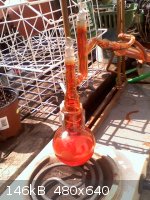 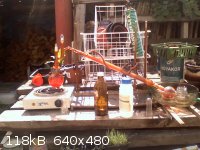 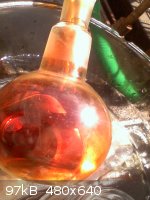 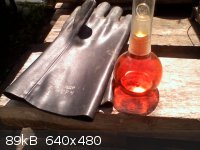
[Edited on 8-8-2011 by Mildronate]
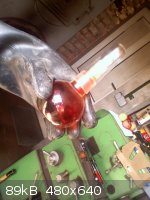 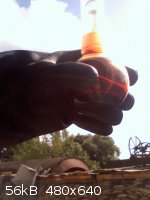
[Edited on 8-8-2011 by Mildronate]
[Edited on 8-8-2011 by Mildronate]
|
|
|
drago57
Harmless

Posts: 16
Registered: 13-8-2011
Member Is Offline
Mood: No Mood
|
|
Quote: Originally posted by Magpie  |
In a 250mL beaker place 50mL of water. To the water carefully add, with stirring, 30mL of Rooto sulfuric acid (96wt%). The beaker should be cooled
in a cold water (or ice water) bath during the addition of the acid. Set aside.
[Edited on 10-12-2009 by Magpie]
|
Externally cooling beakers you're making up acids in isn't such a great idea; sooner or later it will lead to breakages or worse. Much better to add a
bit of acid, leave it to cool, add a bit, leave to cool, etc.
Otherwise great article, I really enjoy reading all these preps for things that at uni I can just get out of the cupboard/fridge. Guess I'm a little
bit spoilt!!
|
|
|
Magpie
lab constructor
    
Posts: 5939
Registered: 1-11-2003
Location: USA
Member Is Offline
Mood: Chemistry: the subtle science.
|
|
Quote: Originally posted by drago57  |
Otherwise great article, I really enjoy reading all these preps for things that at uni I can just get out of the cupboard/fridge. Guess I'm a little
bit spoilt!! |
Yes, anyone doing chemistry in an institutional or industrial setting is spoiled. Home chemists like us do not have that luxury. I think that the
fact that private citizens cannot order chemicals from the major chemical companies is a good thing in the long run. It has forced us to go back to
our roots, learning many fundamental things along the way. The old preps of our ancestors have become rare and valuable literature. Much of this
literature was slowly being lost to society but now we are scrambling to save it. Just look at the forum library! What a treasure trove of
increasingly hard to find literature that is now available to all.
The single most important condition for a successful synthesis is good mixing - Nicodem
|
|
|
cAMP
Harmless

Posts: 24
Registered: 6-7-2011
Location: East Coast, USA
Member Is Offline
Mood: No Mood
|
|
I have just tested an alternate procedure for preparation of elemental bromine, using the somewhat easier to source (at least in the USA) Hydrochloric
Acid, and Bleach (I used Calcium hypochlorite powder).
Procedure for Synthesis of Elemental Bromine (Br2)
Materials Needed
Reagents
Potassium Bromide
Calcium Hypochlorite
10M Hydrochloric Acid
Sodium Thiosulfate
Glassware
250mL round bottom flask with ground glass (GG) joint
Three-way distillation adapter with GG joints
GG or Teflon thermometer adapter
Liebig or West Condenser with GG joints
105o Vacuum take-off adapter with GG joints
100mL receiving flask with GG joint
250mL beaker
Pasteur pipet
Other
Latex rubber or vinyl tubing
Condenser pump, and requisite tubing
Procedure:
Step 1: Preparation of Hydrobromic Acid
1. Add 20g KBr to the round-bottom flask
2. Add just enough water to dissolve the KBr with vigorous stirring
a. If required, you may heat the water to encourage more KBr to dissolve
3. Add a stoichiometric quantity of 10M HCL
a. 20g KBr (s) / 119.002g/mol = 0.168mol KBr
b. 10M HCl (aq) = 0.168mol / 10mol HCl / L = 0.0168 L HCl (aq) = 16.8mL HCl
4. Stir to react the two reagents
KBr (s) + HCl (aq) --------> HBr (aq) + KCl (s)
Step 2: Production of Elemental Bromine in situ
1. Add excess hypochlorite to fully oxidize all of the HBr to Br2
2. Stir to react
a. This step is very exothermic and will produce choking clouds of corrosive Br2 vapor.
Do not inhale the vapor. From this point on, this procedure must be performed in a good fume hood or outside.
4HBr (aq) + Ca(ClO)2 (aq) ------> CaCl2 (aq) + 2H2O (L) + 2Br2 (L)

Step 3: Distillation of Elemental Bromine
1. In an all glass distillation apparatus (rubber or neoprene stoppers cannot be used because they are attacked by Br2) set up for simple
distillation.
2. Attach a natural rubber latex or vinyl tubing length, cut to approximately 12” long to the vacuum take off hose barb, and the other end to a
pasteur pipet
3. Make up a fairly strong solution of Sodium Thiosulfate that will act as the scrubbing solution in a 250mL beaker.
4. Clamp or suspend the pipet tip in the Sodium Thiosulfate solution.
5. Fit a heating mantle or other suitable heating device to the 250mL round-bottom flask containing the reaction mixture from step 2.
6. Fit an all glass thermometer or thermometer on a teflon adapter to the 3-way distillation adapter.
7. Connect the condenser pump so that cold water is flowing in through the bottom hose-barb and out the top.
8. Start the condenser pump.
9. Begin heating the 250mL round-bottom flask until the temperature reaches 58.8oC
a. At this point Elemental Bromine will start distilling over
b. We can do this separation because none of the other components of the mixture in the RBF boil as low as Br2
10. Continue with distillation until the temperature in the still head begins to rise above 60oC.
a. This this point, other components, including water will start to distill over, contaminating the relatively pure Br2.
Step 4: Purification of the Bromine
1. If you require exceptionally anhydrous bromine, such as for an organic synthesis, you can dehydrate the bromine by adding small amounts at a time
of concentrated (98%) sulfuric acid and shaking the two together.
a. The two reagents will phase separate, and the H2SO4 will scavenge all of the water dissolved in the bromine.
b. If this is done in a separation funnel, make sure to vent often, especially if this procedure is scaled up.
Step 5: Storage of Elemental Bromine
1. Elemental bromine is a highly reactive, corrosive reagent that can only successfully be stored either in a glass ampoule, or in a specially made
reagent bottle with a thick teflon lining, where it cannot react with its container.
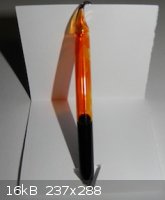
[Edited on 7-10-2012 by cAMP]
"You just spent the entire night arguing grand unification theories with Albert Einstein!" - Geordi LaForge
|
|
|
UnintentionalChaos
International Hazard
    
Posts: 1454
Registered: 9-12-2006
Location: Mars
Member Is Offline
Mood: Nucleophilic
|
|
For those of you who don't follow me on youtube or don't want to sit through the relatively long video, here is the text version of my 1.5mol scale
Br2 prep, guaranteed to be free from BrCl contamination and without risk of the vigorous reaction present in the H2O2-based prep. All joints
should be heavily greased to prevent escape of bromine vapors.
A 1L, 1-neck RBF is charged with 308.7g NaBr (3mol) dissolved in 350ml of water. NaBr forms a room-temperature stable dihydrate, so it is advantageous
to dry it out in an oven on a low setting before measuring to ensure proper stoichiometry. With stirring, which is to be maintained throughout the
entire process, 94.8g of finely powdered KMnO4 is added. Without acid added, no significant amount of bromine will form.
A 3-way adapter is added and atop the 3-way adapter is placed an addition funnel capable of holding 280ml of liquid. (The author's 250ml funnel has
some headspace above the graduations that allows the additional 30ml to be added). After ensuring the stopcock is closed (If it isn't, it could get
ugly, fast) it is charged with 500g (~280ml) of drain cleaner sulfuric acid, which is typically about 93%. This amount is a 10% excess in addition to
the conservative assumption that the acid is only 90%.
The rest of a standard distillation setup is added and a water or alkaline sulfite scrubber may be attached to the vacuum takeoff if you do not
possess a fume hood. Both are somewhat susceptible to suckback, so either a suckback trap or the inverted funnel method of assembling a scrubber are
strongly recommended. The receiving flask should sit in an ice bath to reduce product volatility and the condenser should be supplied with ice water
to ensure efficient condensing.
Slow addition of sulfuric acid is begun and bromine vapors are immediately visible in the headspace of the flask. After a certain point, bromine
begins to self-distill as the addition of H2SO4 to the solution is highly exothermic. If water should being to distill at any appreciable rate,
sulfuric acid addition is stopped and the reaction mixture allowed to cool before resuming addition. Once all the sulfuric acid is added, external
heating is applied. When water begins to distill, heating is stopped. The reaction flask should be extremely light in color, essentially all bromine
having been expelled.
The product consists of a biphasic mixture of bromine and water. The upper water phase is removed mechanically, either by use of a pipette or by
separatory funnel. The lower bromine phase is chilled in an ice bath and transferred to a separatory funnel. 25ml of concentrated sulfuric acid is
added and the funnel is shaken, with frequent venting. After settling, the lower bromine phase is drained off into a suitable storage container
(fluoropolymer or glass with fluoropolymer-lined cap). The product weighs 228g, representing a 95% yield from NaBr. It is preferrably stored in a
freezer below it's m.p. which dramatically reduces volatility.
Video is available here:
http://youtu.be/AL9ehxTaYRs
Department of Redundancy Department - Now with paperwork!
'In organic synthesis, we call decomposition products "crap", however this is not a IUPAC approved nomenclature.' -Nicodem
|
|
|
mr.crow
National Hazard
   
Posts: 884
Registered: 9-9-2009
Location: Canada
Member Is Offline
Mood: 0xFF
|
|
I greatly enjoy your videos, UC
How well does the FEP bottle work? Doesn't the bromine still diffuse through the plastic?
Also, there must be a lot of MnSO4 in the flask. Did you recover this?
Double, double toil and trouble; Fire burn, and caldron bubble
|
|
|
UnintentionalChaos
International Hazard
    
Posts: 1454
Registered: 9-12-2006
Location: Mars
Member Is Offline
Mood: Nucleophilic
|
|
Quote: Originally posted by mr.crow  | I greatly enjoy your videos, UC
How well does the FEP bottle work? Doesn't the bromine still diffuse through the plastic?
Also, there must be a lot of MnSO4 in the flask. Did you recover this? |
The FEP bottle is excellent. I always store my bromine frozen at -20C except when I need to use it. While bromine has penetrated into the plastic over
perhaps the last year (maybe more), making it faintly red-brown, I don't believe that it has come all the way through. The scent of bromine is not
detectable outside the bottle.
I didn't bother to recover the MnSO4. There is a huge amount of sodium and potassium bisulfite in there too. You could recover the Mn (II) as
carbonate by diluting the stillpot to a few liters and pitching in tons of sodium carbonate, then filtering the product off, but I already have a
bunch of Mn (II) salts, none of which I have used as far as I know.
Department of Redundancy Department - Now with paperwork!
'In organic synthesis, we call decomposition products "crap", however this is not a IUPAC approved nomenclature.' -Nicodem
|
|
|
XeonTheMGPony
International Hazard
    
Posts: 1636
Registered: 5-1-2016
Member Is Offline
Mood: No Mood
|
|
followed this and well it worked great
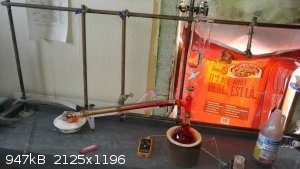 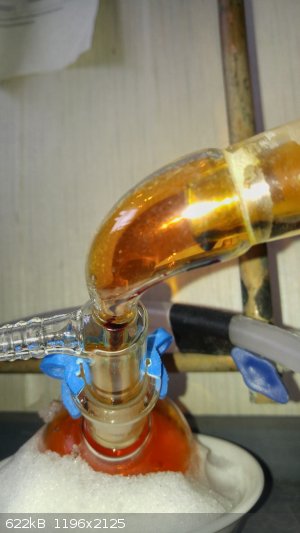
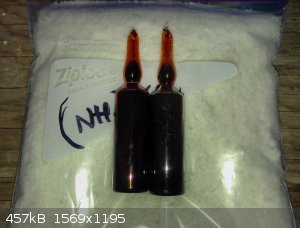
|
|
|
S.C. Wack
bibliomaster
    
Posts: 2419
Registered: 7-5-2004
Location: Cornworld, Central USA
Member Is Offline
Mood: Enhanced
|
|
Some obvious variations might be worth mentioning here,where no fume hood is needed. Maybe you'd like to know that it's not something to fear when
everything is set up wisely. It could be kilos in an apartment bedroom and no one would notice.
First, not_important didn't exactly suggest bubbling the vapor into base. It's best to avoid that sort of thing whenever possible. I use 2 gas washing
bottles in series with PVC hose. Br vapor is heavy, it sinks. A tall graduated cylinder with a little aq. NaOH inside, and a hose leading not quite
under the surface, with some cotton stuffed around the top, probably would work just as well, because there's no color in my second bottle even though
there's barely any water in them. Or the tube could go into a graduated cylinder and the whole thing packed with wool of some sort wetted with aq.
NaOH.
Second, to Jor's point, once the Br stops coming over, assuming there is still water present, quickly replace the receiver (I suggest an apothecary
bottle, also for storage) with a RBF with dissolved NaOH in it. Turn up the heat until the boiling flask, condenser, and vacuum adapter is colorless.
Some Br may remain in the joint grease, and the receiver yellow from hypobromite. Heat the receiver slightly and it will turn to bromate. But there is
bromide as well since the last bit is probably Br dissolved in HBr.
Last, the order of things can be changed. I wanted to get rid of my HBr. Adding diluted H2SO4 to HBr, and then adding H2O2 to that, is not freaky (if
done with care). One may worry now about H2SO5 or something, but nothing explodes. I suggest setting up for distillation and all, but with a cooling
bath and magnetic stirring during the peroxide addition, then replacing that with a mantle after. US5266295 uses 48% HBr, 35% H2O2, and 53% H2SO4:
112.8 g 95% H2SO4 is added to 91.6 g water, and this (after cooling down) is added to 141.6 g 48.84% HBr. Over 4 hrs., 41.4 g 35% H2O2 is added at
15-35C. This mixture is heated to 55C for 2.5 hrs., 66.6 g Br is distilled. I'm not sure that less sulfuric acid hurts really. The H2O2 can be added
faster with cooling. Have some aq. NaOH handy to shake in the stoppered funnel after the addition, and it's not a bad experience at all.
(FEAR THE DEER)
|
|
|
draculic acid69
International Hazard
    
Posts: 1371
Registered: 2-8-2018
Member Is Offline
|
|
I've done this at 1/4 & 1/2 scale. 95% of theoretical yeild consistently.
Good method. Haven't tried h2o2 instead of kmno4 get so can't compare yeilds yet.
|
|
|
Keras
National Hazard
   
Posts: 766
Registered: 20-8-2018
Location: (48, 2)
Member Is Offline
|
|
I’m awaiting a batch of Oxone™ and sodium bromide. I’m sure mixing both will do the trick, too. Oxone is advantageous: it is cheap, non
restricted, and has the oxidation power of Caro's acid.
[Edited on 5-8-2021 by Keras]
|
|
|
RustyShackleford
Hazard to Others
  
Posts: 195
Registered: 10-12-2020
Location: Northern Europe
Member Is Offline
|
|
Oxone works very well. I obtained an 88% yield using: 50g NaBr, 80g oxone and 60g 50% sulfruric acid.
I mix the powders dry a dry 3 neck RBF. Then connect it to a distillation apparatus and via addition funnel add 25ml water then the sulfuric acid.
Its important to have it connected to the distillation apparatus when adding the water and acid, because the heat generated boils out a lot of the
bromine, then you heat w plate or mantle to drive out the rest.
[Edited on 5-8-2021 by RustyShackleford]
|
|
|
Keras
National Hazard
   
Posts: 766
Registered: 20-8-2018
Location: (48, 2)
Member Is Offline
|
|
What's the purpose of the sulphuric acid here? Isn't oxone already oxidising enough to get the bromine out?
|
|
|
Tsjerk
International Hazard
    
Posts: 3022
Registered: 20-4-2005
Location: Netherlands
Member Is Offline
Mood: Mood
|
|
The purpose of the acid is to make Caro's acid, without it oxone is quite gentle. I used it as a powder without any safety precautions to clean
equipment used in food industry. I was cleaning with bare hands for hours, nothing was felt.
|
|
|
Keras
National Hazard
   
Posts: 766
Registered: 20-8-2018
Location: (48, 2)
Member Is Offline
|
|
But isn't Oxone already the potassium salt of Caro's acid?
|
|
|
| Pages:
1
2 |